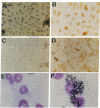Abstract
Epidermal keratinocytes (EK) are exposed to multiple inflammatory stimuli and paracrine factors secreted by various dermal cells (lymphocytes, mast cells, macrophages, fibroblasts) during wounding, cutaneous allergy, and infections. We have previously demonstrated that after stimulation with interleukin 4 or interferon-gamma, human EK express the low-affinity receptor for IgE (Fc epsilon RII/CD23) on their surface. In the present study, we showed that the ligation of CD23 by IgE/anti-IgE immune complexes or specific monoclonal antibody induces a dose-dependent release of interleukin 6 and tumor necrosis factor-alpha from EK. CD23-ligation activates the nitric oxide-dependent pathway, as demonstrated by the high levels of nitrites released in cell supernatants, and the accumulation of intracellular cyclic nucleotides in EK. These second messengers are required for IgE-dependent stimulation of cytokine production by these cells, inasmuch as this is completely abolished by the use of cAMP or nitric oxide synthase antagonists. Human epithelial keratinocytes may thus participate in IgE-mediated immune responses, through their ability to express functional CD23 antigen.
Full text
PDF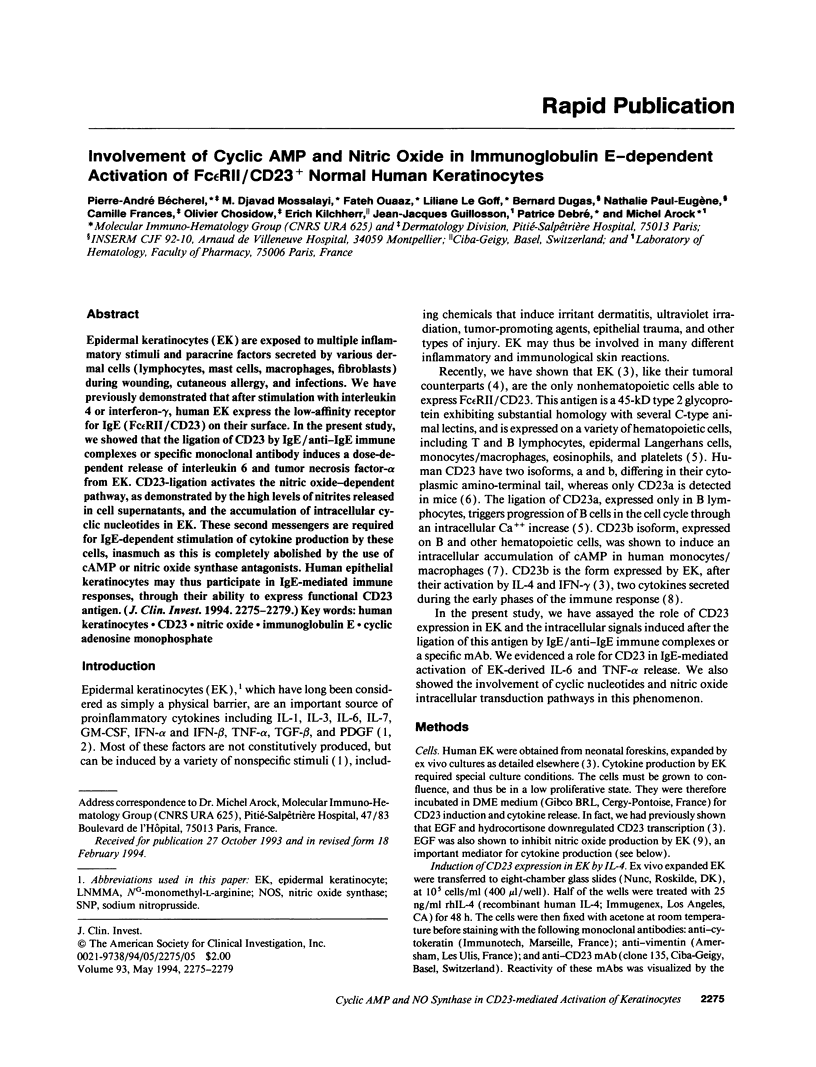
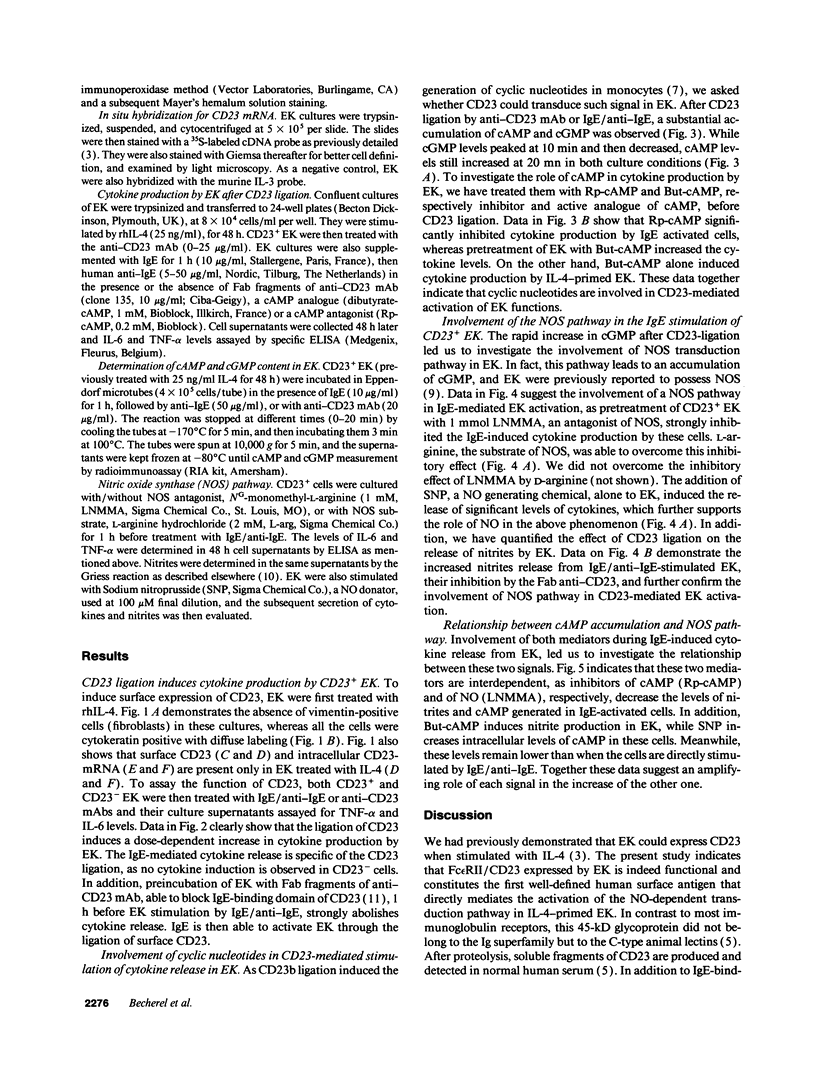
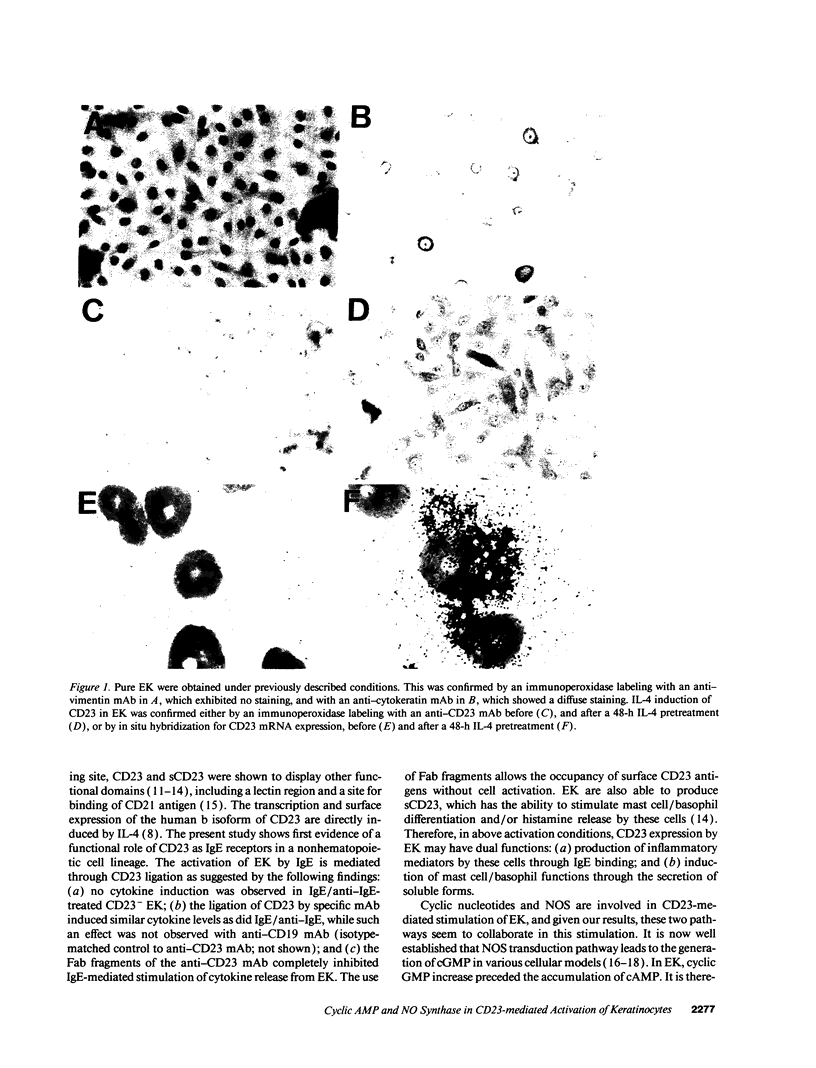
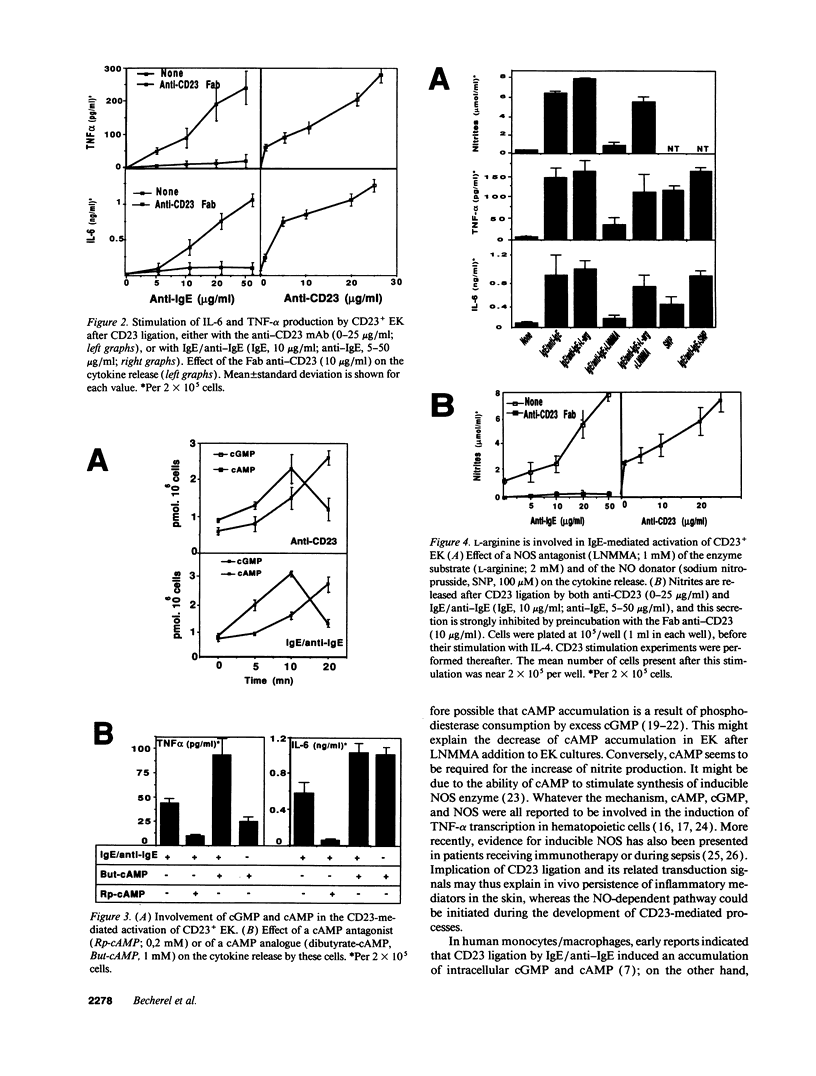
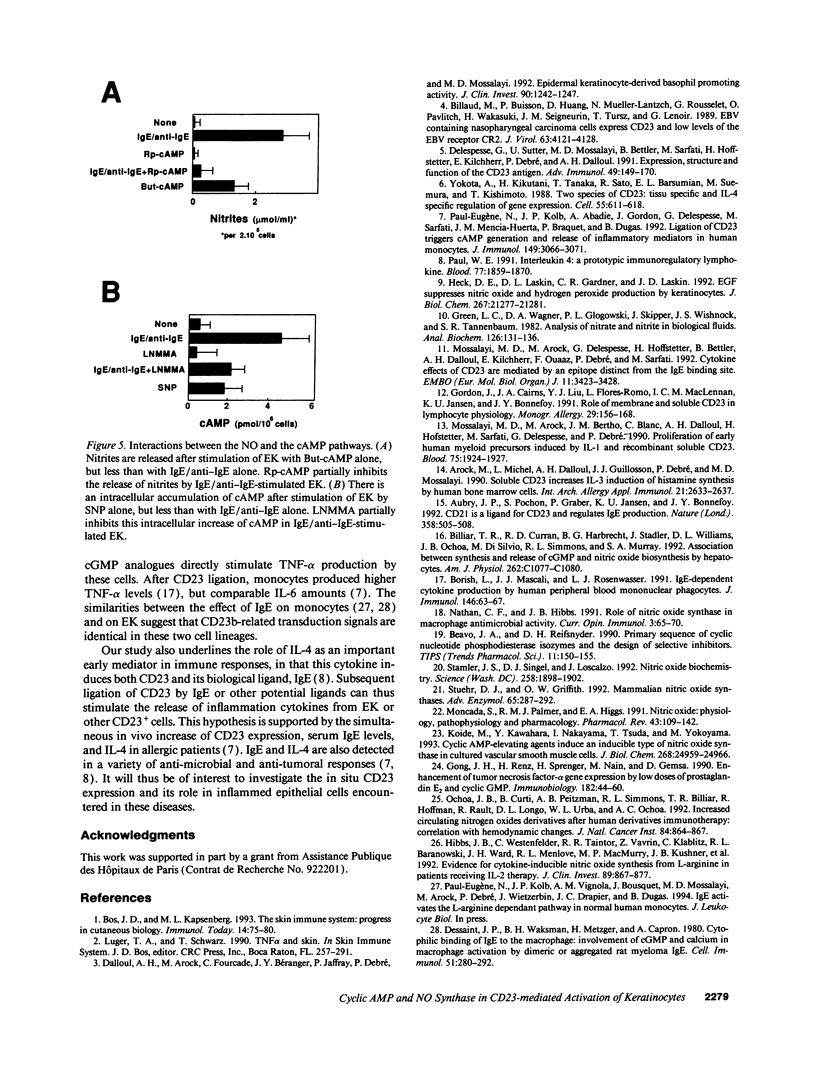
Images in this article
Selected References
These references are in PubMed. This may not be the complete list of references from this article.
- Aubry J. P., Pochon S., Graber P., Jansen K. U., Bonnefoy J. Y. CD21 is a ligand for CD23 and regulates IgE production. Nature. 1992 Aug 6;358(6386):505–507. doi: 10.1038/358505a0. [DOI] [PubMed] [Google Scholar]
- Beavo J. A., Reifsnyder D. H. Primary sequence of cyclic nucleotide phosphodiesterase isozymes and the design of selective inhibitors. Trends Pharmacol Sci. 1990 Apr;11(4):150–155. doi: 10.1016/0165-6147(90)90066-H. [DOI] [PubMed] [Google Scholar]
- Billaud M., Busson P., Huang D., Mueller-Lantzch N., Rousselet G., Pavlish O., Wakasugi H., Seigneurin J. M., Tursz T., Lenoir G. M. Epstein-Barr virus (EBV)-containing nasopharyngeal carcinoma cells express the B-cell activation antigen blast2/CD23 and low levels of the EBV receptor CR2. J Virol. 1989 Oct;63(10):4121–4128. doi: 10.1128/jvi.63.10.4121-4128.1989. [DOI] [PMC free article] [PubMed] [Google Scholar]
- Billiar T. R., Curran R. D., Harbrecht B. G., Stadler J., Williams D. L., Ochoa J. B., Di Silvio M., Simmons R. L., Murray S. A. Association between synthesis and release of cGMP and nitric oxide biosynthesis by hepatocytes. Am J Physiol. 1992 Apr;262(4 Pt 1):C1077–C1082. doi: 10.1152/ajpcell.1992.262.4.C1077. [DOI] [PubMed] [Google Scholar]
- Borish L., Mascali J. J., Rosenwasser L. J. IgE-dependent cytokine production by human peripheral blood mononuclear phagocytes. J Immunol. 1991 Jan 1;146(1):63–67. [PubMed] [Google Scholar]
- Bos J. D., Kapsenberg M. L. The skin immune system: progress in cutaneous biology. Immunol Today. 1993 Feb;14(2):75–78. doi: 10.1016/0167-5699(93)90062-P. [DOI] [PubMed] [Google Scholar]
- Dalloul A. H., Arock M., Fourcade C., Béranger J. Y., Jaffray P., Debré P., Mossalayi M. D. Epidermal keratinocyte-derived basophil promoting activity. Role of interleukin 3 and soluble CD23. J Clin Invest. 1992 Oct;90(4):1242–1247. doi: 10.1172/JCI115986. [DOI] [PMC free article] [PubMed] [Google Scholar]
- Delespesse G., Suter U., Mossalayi D., Bettler B., Sarfati M., Hofstetter H., Kilcherr E., Debre P., Dalloul A. Expression, structure, and function of the CD23 antigen. Adv Immunol. 1991;49:149–191. doi: 10.1016/s0065-2776(08)60776-2. [DOI] [PubMed] [Google Scholar]
- Delespesse G., Suter U., Mossalayi D., Bettler B., Sarfati M., Hofstetter H., Kilcherr E., Debre P., Dalloul A. Expression, structure, and function of the CD23 antigen. Adv Immunol. 1991;49:149–191. doi: 10.1016/s0065-2776(08)60776-2. [DOI] [PubMed] [Google Scholar]
- Dessaint J. P., Waksman B. H., Metzger H., Capron A. Cytophilic binding of IgE to the macrophage. III. Involvement of cyclic GMP and calcium in macrophage activation by dimeric or aggregated rat myeloma IgE. Cell Immunol. 1980 May;51(2):280–292. doi: 10.1016/0008-8749(80)90260-9. [DOI] [PubMed] [Google Scholar]
- Gong J. H., Renz H., Sprenger H., Nain M., Gemsa D. Enhancement of tumor necrosis factor-alpha gene expression by low doses of prostaglandin E2 and cyclic GMP. Immunobiology. 1990 Dec;182(1):44–55. doi: 10.1016/s0171-2985(11)80582-6. [DOI] [PubMed] [Google Scholar]
- Gordon J., Cairns J. A., Liu Y. J., Flores-Romo L., MacLennan I. C., Jansen K. U., Bonnefoy J. Y. Role of membrane and soluble CD23 in lymphocyte physiology. Monogr Allergy. 1991;29:156–168. [PubMed] [Google Scholar]
- Green L. C., Wagner D. A., Glogowski J., Skipper P. L., Wishnok J. S., Tannenbaum S. R. Analysis of nitrate, nitrite, and [15N]nitrate in biological fluids. Anal Biochem. 1982 Oct;126(1):131–138. doi: 10.1016/0003-2697(82)90118-x. [DOI] [PubMed] [Google Scholar]
- Heck D. E., Laskin D. L., Gardner C. R., Laskin J. D. Epidermal growth factor suppresses nitric oxide and hydrogen peroxide production by keratinocytes. Potential role for nitric oxide in the regulation of wound healing. J Biol Chem. 1992 Oct 25;267(30):21277–21280. [PubMed] [Google Scholar]
- Hibbs J. B., Jr, Westenfelder C., Taintor R., Vavrin Z., Kablitz C., Baranowski R. L., Ward J. H., Menlove R. L., McMurry M. P., Kushner J. P. Evidence for cytokine-inducible nitric oxide synthesis from L-arginine in patients receiving interleukin-2 therapy. J Clin Invest. 1992 Mar;89(3):867–877. doi: 10.1172/JCI115666. [DOI] [PMC free article] [PubMed] [Google Scholar]
- Koide M., Kawahara Y., Nakayama I., Tsuda T., Yokoyama M. Cyclic AMP-elevating agents induce an inducible type of nitric oxide synthase in cultured vascular smooth muscle cells. Synergism with the induction elicited by inflammatory cytokines. J Biol Chem. 1993 Nov 25;268(33):24959–24966. [PubMed] [Google Scholar]
- Moncada S., Palmer R. M., Higgs E. A. Nitric oxide: physiology, pathophysiology, and pharmacology. Pharmacol Rev. 1991 Jun;43(2):109–142. [PubMed] [Google Scholar]
- Mossalayi M. D., Arock M., Bertho J. M., Blanc C., Dalloul A. H., Hofstetter H., Sarfati M., Delespesse G., Debré P. Proliferation of early human myeloid precursors induced by interleukin-1 and recombinant soluble CD23. Blood. 1990 May 15;75(10):1924–1927. [PubMed] [Google Scholar]
- Nathan C. F., Hibbs J. B., Jr Role of nitric oxide synthesis in macrophage antimicrobial activity. Curr Opin Immunol. 1991 Feb;3(1):65–70. doi: 10.1016/0952-7915(91)90079-g. [DOI] [PubMed] [Google Scholar]
- Ochoa J. B., Curti B., Peitzman A. B., Simmons R. L., Billiar T. R., Hoffman R., Rault R., Longo D. L., Urba W. J., Ochoa A. C. Increased circulating nitrogen oxides after human tumor immunotherapy: correlation with toxic hemodynamic changes. J Natl Cancer Inst. 1992 Jun 3;84(11):864–867. doi: 10.1093/jnci/84.11.864. [DOI] [PubMed] [Google Scholar]
- Paul-Eugene N., Kolb J. P., Abadie A., Gordon J., Delespesse G., Sarfati M., Mencia-Huerta J. M., Braquet P., Dugas B. Ligation of CD23 triggers cAMP generation and release of inflammatory mediators in human monocytes. J Immunol. 1992 Nov 1;149(9):3066–3071. [PubMed] [Google Scholar]
- Paul W. E. Interleukin-4: a prototypic immunoregulatory lymphokine. Blood. 1991 May 1;77(9):1859–1870. [PubMed] [Google Scholar]
- Stamler J. S., Singel D. J., Loscalzo J. Biochemistry of nitric oxide and its redox-activated forms. Science. 1992 Dec 18;258(5090):1898–1902. doi: 10.1126/science.1281928. [DOI] [PubMed] [Google Scholar]
- Stuehr D. J., Griffith O. W. Mammalian nitric oxide synthases. Adv Enzymol Relat Areas Mol Biol. 1992;65:287–346. doi: 10.1002/9780470123119.ch8. [DOI] [PubMed] [Google Scholar]
- Yokota A., Kikutani H., Tanaka T., Sato R., Barsumian E. L., Suemura M., Kishimoto T. Two species of human Fc epsilon receptor II (Fc epsilon RII/CD23): tissue-specific and IL-4-specific regulation of gene expression. Cell. 1988 Nov 18;55(4):611–618. doi: 10.1016/0092-8674(88)90219-x. [DOI] [PubMed] [Google Scholar]



